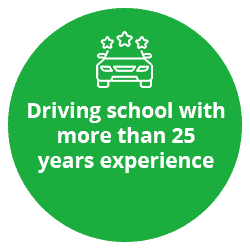Hold-an Vej 20C
2750 Ballerup
CVR: 27192459

Designate (know the location of)
Read and understand (when driving be able to react to)
Lights, reflectors and horns
All required lights and reflectors must be undamaged and clean, and all lamps must function.
Lights in a pair must have the same colour and brightness.
The dipped (low) beam should not be blinding and they shall dip down at an angle of 1 % = 1 cm for each meter. One can check them by, holding a finger where the light source hit the leg – close up each light then move back 1 meter, and it should drop 1 cm.
The three red stop lights must give significantly more powerful light than the taillights.
The indicator lights must blink at the same time, with yellow light that can be clearly seen in sunlight.
The hazard warning light must be able to turn on all indicator lights at the same time.
License plate light(s) must have white light to illuminate the rear license plate.
The horn must have a clear, constant tone.
Steering
There should not be any free play in the steering wheel, meaning the wheels react immediately follow the steering wheels movement.
To check the steering, one must start the engine first, because the power steering (servo) works only with the engine running. Stand outside the vehicle with the side window down, so you can turn the steering wheel from outside.
Move the steering wheel slightly side to side (with one hand) and see the nearest front wheel is responding. To make sure the wheel on the right side works the same, ask for help to turn the steering wheel while you look to see if that wheel responds immediately.
Brakes
The brake pedal should not go all the way down to the floor, when the pedal is pressed hard. The brake pedal must not sink while being held down at constant pressure. In most cars the pedal should go half way down, this is dependent on the make of the car.
The brake vacuum amplifier is checked by pumping the footbrake 6 – 9 times. Hold it down and then starting the engine. The amplifier works if the pedal sinks. Remember to hold down the clutch while starting the engine.
The fluid level in the brake fluid reservoir must be between min. – and max. mark.
Engine and exhaust system, etc.
The engine should not generate unnecessary smoke and noise. Start the engine, look for smoke from the exhaust pipe and listen for any abnormal sounds.
The exhaust system should not be loose or have any holes. Use your foot to softly kick to the exhaust pipe to see that it is tight.
Engine oil must be filled in a sufficient quantity. Read on the dipstick minimum and maximum marks or follow the instruction manual. When the engine is cold, pull the dipstick oil indicator out and wipe it with a piece of paper. Insert the indicator back in place and carefully take it out again. The oil will stick the stick and you can see if it is between min. and max.
Coolant fluid must be filled in a sufficient quantity (to the instruction manual), normally between the minimum and maximum marks.
Sprinkler fluid must be filled in a sufficient quantity, enough for the next drive.
Carrying parts
Tires must have a depth of at least 1.6 mm in the main pattern on all wheels, possibly judged by the thread wear indicators. Use your finger to feel for the bump in the pattern. When the bump (T.W.I) is at the same height as the top of the tire you must change it.
Tires and rims must be without damage.
Shock absorbers must be effective on all wheels, judged by the fact that the car is at a standstill immediately after a strong impact on the shock absorbers. Be careful not to dent or scratch the car while pressing down over the wheels.
Are you searching for a driving school near Copenhagen that focuses on quality? Don’t hesitate to contact us. We are ready to guide you so you can get the driving license as quickly as possible.